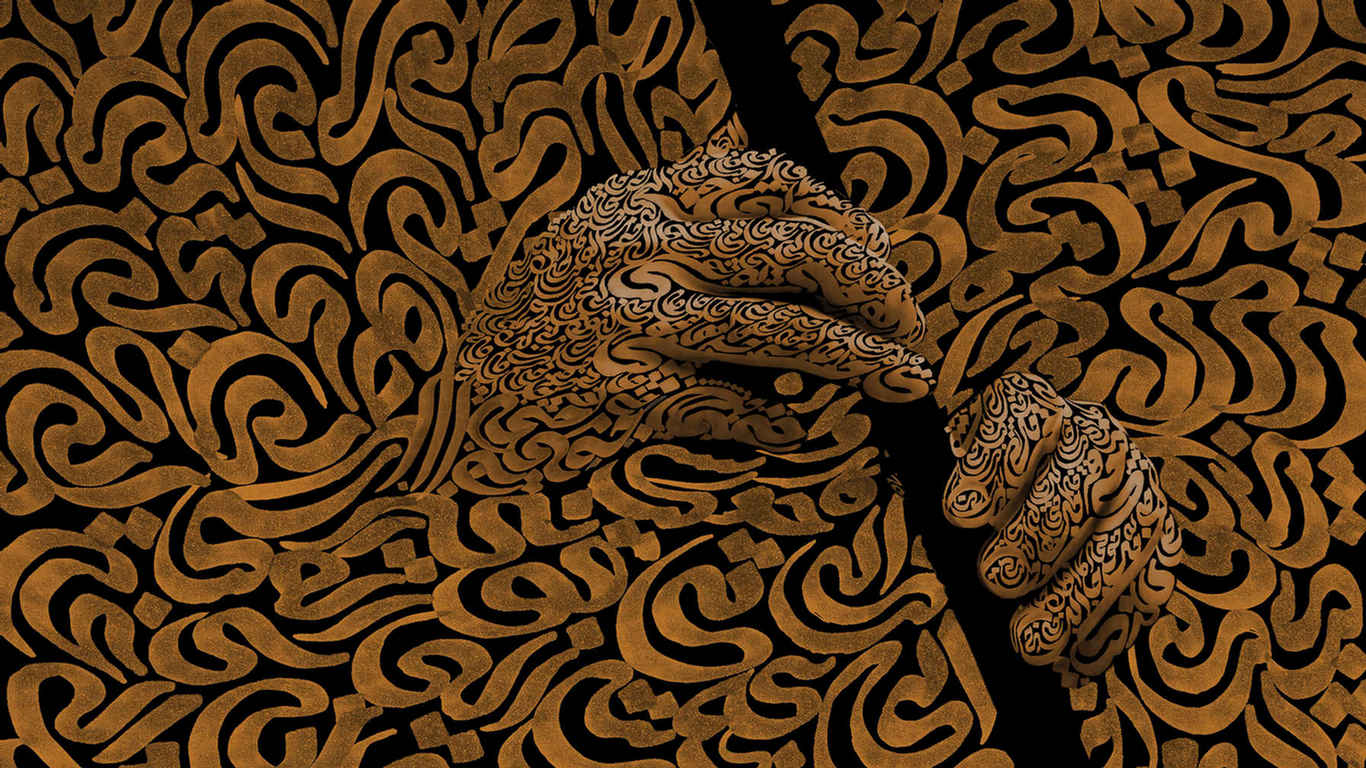by John Feffer
Mehdi Saeedi turns words into art. The Iranian graphic artist has transformed Farsi script into posters, paintings, and other works. He has taken a traditional form, calligraphy, and made something even more startling and beautiful from it.
In Saeedi’s posters, a line of script turns into a bird, with an olive branch in its beak. Don Quixote rides a horse of words, a reminder that the knight’s adventures were inspired entirely by books. Emerging from a swirl of poetry are two hands, themselves tattooed with calligraphy, holding a traditional flute.
“My work goes back to the 14th century, a time when calligraphers applied and used the practice of calligraphy in illustrations,” Saeedi told me. “An example I can give you is the Bird of Bismillah in which the calligraphers created an image merely for aesthetic reasons. But after that, what calligraphers were doing had more of a religious and spiritual dimension. Because they believed that God is beautiful, they decided to illustrate this in the shape of a beautiful bird, where they would write the name of God, in the name of God, the most gracious, the most merciful.” This phrase, known as the “bismillah,” is the first line of the Koran.
With his reinvention of the calligraphic tradition, Saeedi has become a famous artist in Iran at a relatively young age. More than that, he has acquired an international reputation. He was won many international awards, including grand prizes in poster competitions in Japan and Taiwan, and has exhibited in in 250 galleries all over the world. His work is currently on display in Washington, DC at the Alex Gallery in September.
Saeedi starts from a set of specifically Iranian elements – the Farsi language, images from traditional Persian culture – and manages to create something universal.
“I realized from the beginning that if I just focused on Persian calligraphy, it would limit my audience to Iran, and then only they would be able to read it,” he said. “However, an image is something that is universal and comprehensible. Therefore, I tried to use the technique of Persian calligraphy in creating an image to which I can connect via its beauty.”
Saeedi was greatly influenced by Polish poster art. As a recent short documentary about his art explains, the recent explosion of Iranian graphic arts parallels the flourishing of poster art in Poland in the 1970s and 1980s: the emergence of a number of distinct styles and approaches that together form a body of national work that has attracted attention and international awards.
The calligraphic tradition, associate curator of contemporary Asian art at the Sackler and Freer Galleries Caroline Huh explained at a recent Atlantic Council event devoted to the graphic arts in Iran, has often served to “animate surfaces, lend significance to buildings and objects, and provide beauty.” Calligraphy is sometimes an adornment, sometimes part of a meditative practice. In Iran, it has been intimately connected to the poetry that has long attracted a worldwide audience.
Saeedi has created a number of posters devoted to Rumi, the well-known Persian poet. “I love Rumi and his poetry,” he said, showing me a poster of the hands of the poet playing the traditional Persian flute known as the ney. “The poem of Rumi is duplicated in the image where we also see the shape of the hands of Rumi playing the ney.”
He is currently working a new series connected to the Shahnameh, the world’s longest poem by a single author. Composed around the 10th century, it provides an account, in couplets, of ancient Persian history. Saeedi is trying to find the right script for the project – Iranian calligraphy draws on several different scripts – to provide a fresh, modern image of this venerable text.
Saeedi achieved enormous success within Iran as a graphic artist. To challenge himself, he has come to the United States to absorb new influences.
Meanwhile in Iran, the art scene continues to expand. Women artists are becoming more prominent and taking on more feminist-inflected themes, reported Hengameh Fouladvand, the executive director of the Center For Iranian Modern Arts in New York at the Atlantic Council event. “There’s more avant-garde work from women now than under the Shah.”
“Gallery space is a semi-public space,” Lila Nazemian of the Lila Heller Gallery in New York explained at the same event. “You have to be part of the community to find it. A regular person wouldn’t walk into a gallery. The openings in Tehran are on Fridays, and a small group of people comes every week. At these galleries there are back rooms where artists can show more risqué work, such as nudity or political work.”
Graphic artists, Nazemian continued, have the same status as any other visual artist in Iran. In this environment, Mehdi Saeedi achieved not only national but international success.
“Many of Mehdi’s works have a core international message and meaning with a Iranian surface,” points out Shahrooz Shekaraubi, the the founder and president of the Aftab Committee, an organization devoted to Iranian culture that organized the Saeedi exhibit. “This is what makes his work so appealing to diverse audiences. There’s much to connect with.”
Image: Detail of a work by Mehdi Saeedi (courtesy of Mehdi Saeedi)





